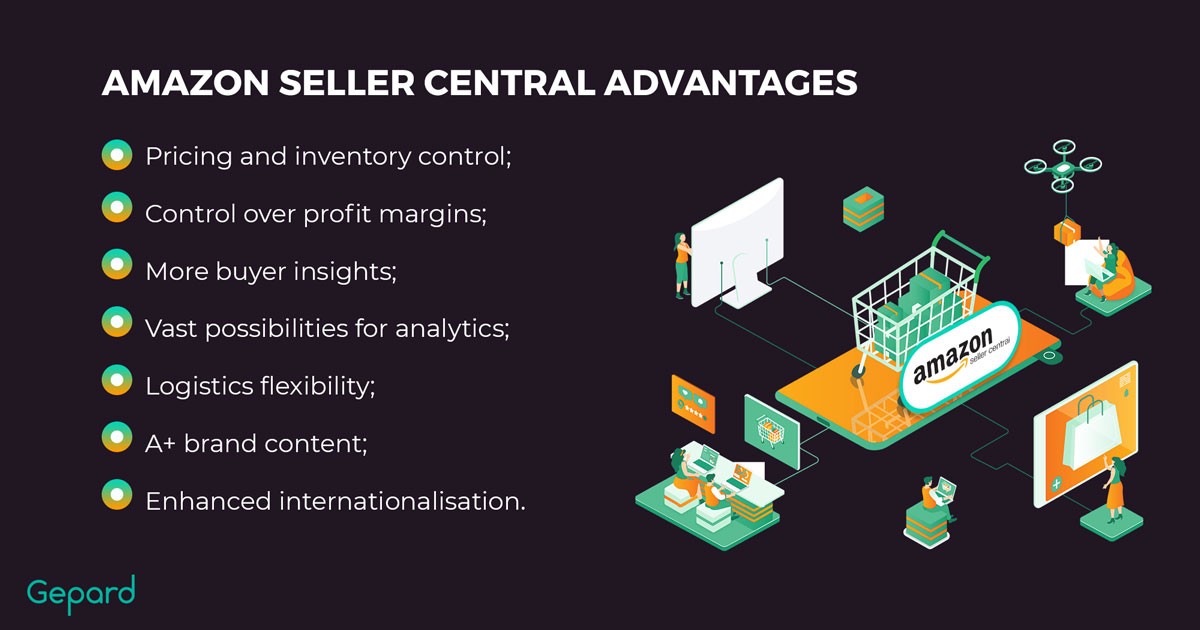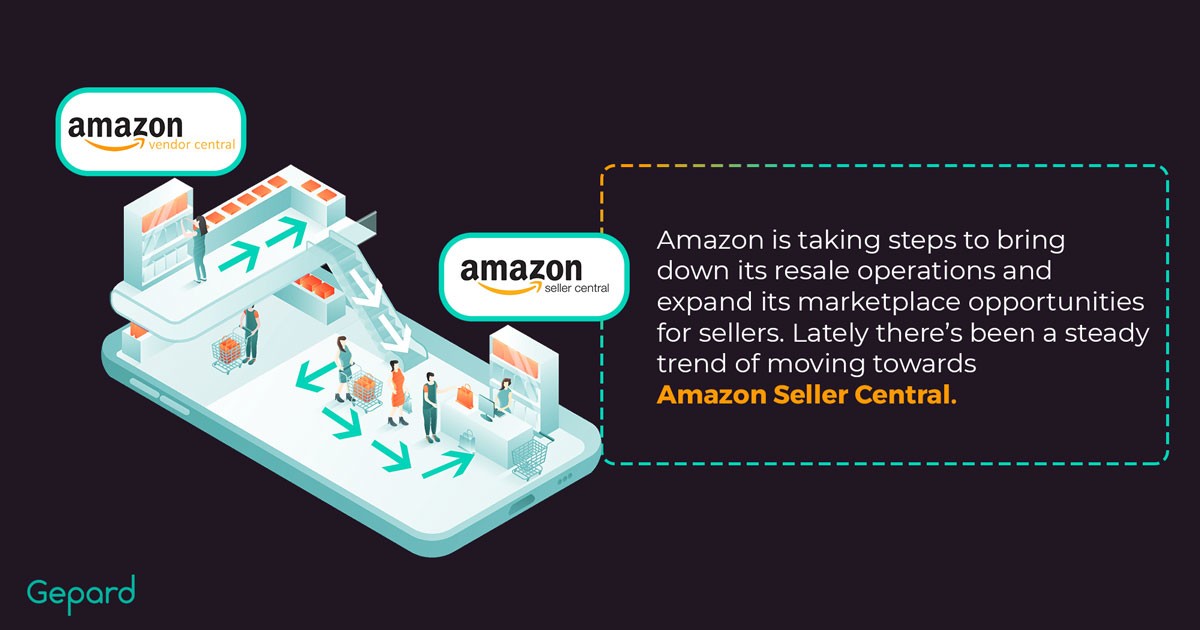Amazon Seller Central: The Smooth Integration With The Platform
Selling through Amazon using Amazon Seller Center is one of the rapidly developing eCommerce trends among businesses who chose the omnichannel strategy.
The biggest online retail platform, Amazon, opens numerous opportunities for growing your business, building brand awareness, and increasing sales. 89% of buyers agree that they would rather buy products on Amazon than on any other sales platform. However, Amazon is not standing still and keeps changing its features for sellers. This means it’s crucial for businesses to keep up with them to stay ahead of the competition.
What Is Amazon Seller Central And Amazon Vendor Central?
Selling on Amazon comes with numerous fulfillment options, one of which is choosing the suitable option between Amazon Vendor Central or Amazon Seller Central.
The main difference between these two hubs is the point of selling contact. In the case of Vendor Central, Amazon buys the products from smaller vendors and resells them to buyers. Meanwhile, with Seller Center, you can sell directly to customers through the marketplace.

Vendor Central provides an opportunity to sell under a credible Amazon brand, to ensure customer confidence and trust, however, vendors cannot influence the pricing and do not have messaging control.
On the contrary, Amazon Seller Central empowers businesses to control pricing, product listings, and inventory. A significant amount of product data, provided by the Amazon Seller Center, gives the seller vast possibilities for analytics.
Amazon Trends: Moving to Seller Central
Since 2019, the Amazon community has been sharing news about an extensive reduction in the number of vendors on Vendor Central Hub. The breaking point was in March 2019 when all of a sudden Amazon canceled thousands of weekly orders principally from vendors who did not reach the $10 million mark. According to the unofficial preliminary information, Amazon Vendor Central API will not be supported in the near future. The expected, yet unconfirmed, the date is the 20th of January, 2022
Although Amazon rejected speculations about closing Vendor Central and transiting vendors to Amazon Seller Center, it kept following the tendency of turning from a retailer into a marketplace and slowly moving towards Seller Central.

Numerous reports highlighted the evidence of Amazon slowly disconnecting smaller vendors from Vendor Central Amazon and moving their business operations to Seller Central Hub. Instead of the wide-reaching changes, Amazon started regularly imposing more limitations and restrictions on vendors, setting new rules for them and motivating them to move to Seller Central. One of the clear pieces of evidence was the requirement for vendors to either register at Amazon Brand Registry (which implies a long process of creating a trademark) or shift to Amazon Seller Center instead.
Why Push To Amazon Seller Central?
While there are different predictions about these two Amazon hubs merging into one Seller Central, as well as there are attempts to refute the rumors, one thing is clear: the transition towards Amazon Seller Center is unavoidable, as it is business-wise for both Amazon and businesses who sell there.
Since Amazon is not going to slow down in terms of optimizing its operations, and moving all sellers to Amazon Seller Center looks like a long term strategy, it’s saleswise for businesses to take precautions and be ready for any future transitions, not to be caught off-guard later. Smooth conversion to Amazon Seller Central is a key to stable sales, customer satisfaction, brand loyalty, and fewer risks.
What Is Amazon API And How Can One Use It?
Using API integrations is one of the main features of Amazon Seller Central. Amazon API gateway is a fully-run service that enables developers to create, publish, manage, and monitor Amazon APIs at any level.
Amazon Selling Partner API was launched in October 2020, and since then it has been opening more opportunities not just for Amazon developers, but also for sellers. With API Amazon the sellers can choose the information they share with applications, and in such a way, enhance their privacy and get more control over their sales information.
Here’s a list of the most useful Amazon API for the sellers:
- A+ content API
- Authorization API
- Catalog Items API
- Feeds Items API
- Listings Items API
- Notifications API
- Product Type Definitions API
- Reports API
- Tokens API
- Uploads API
Now the sellers can grant access to the specific data, depending on the application they use to get the most value out of it. With the Amazon seller center API, the sellers get the new functionality suite to sell their products on Amazon more effectively.
While more brands choose to sell on Amazon Seller Central to fully run their business operations, receiving more control over your sales also brings more responsibilities. Even though managing your own marketing and sales seems like a benefit, it might be difficult to manage the massive amount of product information, especially if you do not have enough knowledge base for it.
Constantly studying customers’ behavior, taking care of all the customer transactions, updating product feeds and listings, and adjusting it to Amazon requirements takes time and resources. That’s why the idea of eCommerce integration with Amazon becomes of topical interest for businesses.
How Should One Choose eCommerce Integration With Amazon?
The key to a smooth migration to Seller Central is the proper preparation. Here are the main steps you need to take:
1. Plan the switching time. It involves choosing the best time for migration and risk evaluation. For example, certain days, such as Black Friday, are not the best fit for a transfer. Also, for seasonal products, it’s better to wait till the peak time is over.
2. Check your inventory. For the smooth transition, it’s better to wait till your product supply runs out. Set up your inventory tracking system and make sure it’s under Amazon Seller Center control.
3. Do the transfer. It includes registering a Seller Central Account, preparing new product listings with the same ASINs, to save the existing product reviews and classifications. You’ll also have to choose product fulfillment options (either handled by Amazon or by yourself) and work on your business logistics.
4. Test your products. Firstly, all your products will have to meet the Amazon Seller standards and taxonomy, then you’ll be responsible for product testing (the consumer demand and product performance).
5. Transfer the advertisements. Learn how Amazon Seller advertising works, practice using its tools and migrate the campaigns. Also, running a few test campaigns is recommended.
6. Re-assign the business roles. The new business processes might require new business roles or re-delegating responsibilities. You’ll definitely need to bring a more personal attitude to customer service. You’ll also have more things to control, such as pricing, inventory, advertisement, and others.
Moving to the direct-to-consumer Amazon model implies that you, as a seller, will have to take control not only of your product inventory, pricing and performance, but also manage advertising, customer care, and satisfaction and optimize your business strategy to keep pace with your competitors.
You can take care of this by yourself or entrust it to a turn-key eCommerce platform that will automate your data-related processes, gives you a guarantee of a pain-free migration and installs an ongoing integration of your business with Amazon.

Here is what you can do with the successful eCommerce integration:
- Manage product listings, avoid out-of-stock risks;
- Manage A+ content with the Amazon Selling Partner API;
- Keep selling with confidence even during hijacking attacks;
- Reduce product data related errors;
- Maximize product feed performance;
- Reduce operational costs;
- Speed up time to market;
- Increase Amazon revenues;
- Saving money on hiring developers.
Entrust Your Amazon Migration To A Turn-Key eCommerce Platform
Omnichannel strategy keeps being on the rise, so are the profits of the companies who chose to sell on multiple marketplaces. We predict the future of eCommerce being shaped by automation and integration with new sales platforms.
Selling on Amazon is one of the key goals for many businesses: it’s more popular and trusted than almost every other sales platform, it increases profits, customer satisfaction, and brand awareness. Gepard can help you facilitate this process and set the custom integrations with Amazon for your brand. We’ll set you free from time-consuming manual work by automating your product data synchronization with Amazon. Our retailer-specific content is regularly going through verification and update procedures to ensure its maximum effectiveness.
Gepard was a partner in launching a Syndicator for Amazon Feed Specification Program and now extensively working on developing a connection with Amazon Seller Central. We’re ready to lean on our experience to solve the challenges of your business. Our dedicated specialists will set up a seamless integration of your business with Amazon Seller Central and help you sell your products on one of the biggest online marketplaces. Gepard is ready for the upcoming transition and can already help you to push your products to Amazon Seller Central.
Reach out to us to learn more about connection to Amazon, or stay tuned, if you want to know how Gepard is keeping up with the ongoing and future Amazon eCommerce trends.





